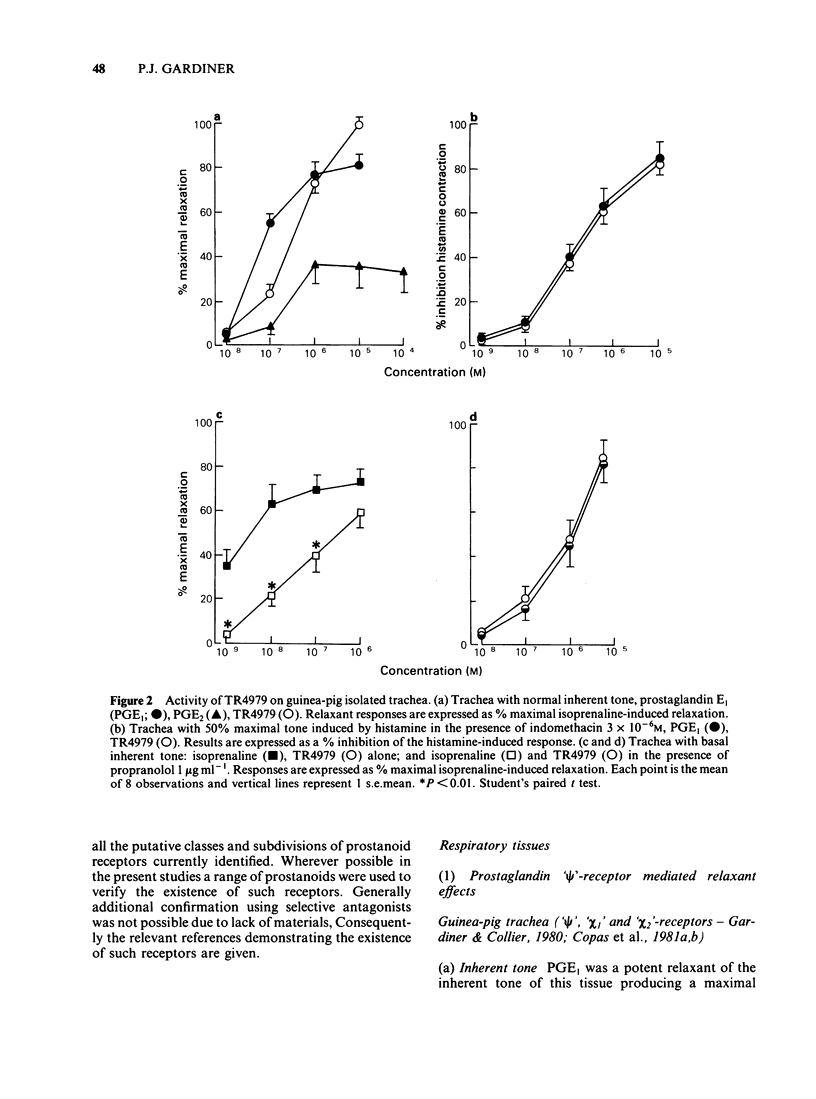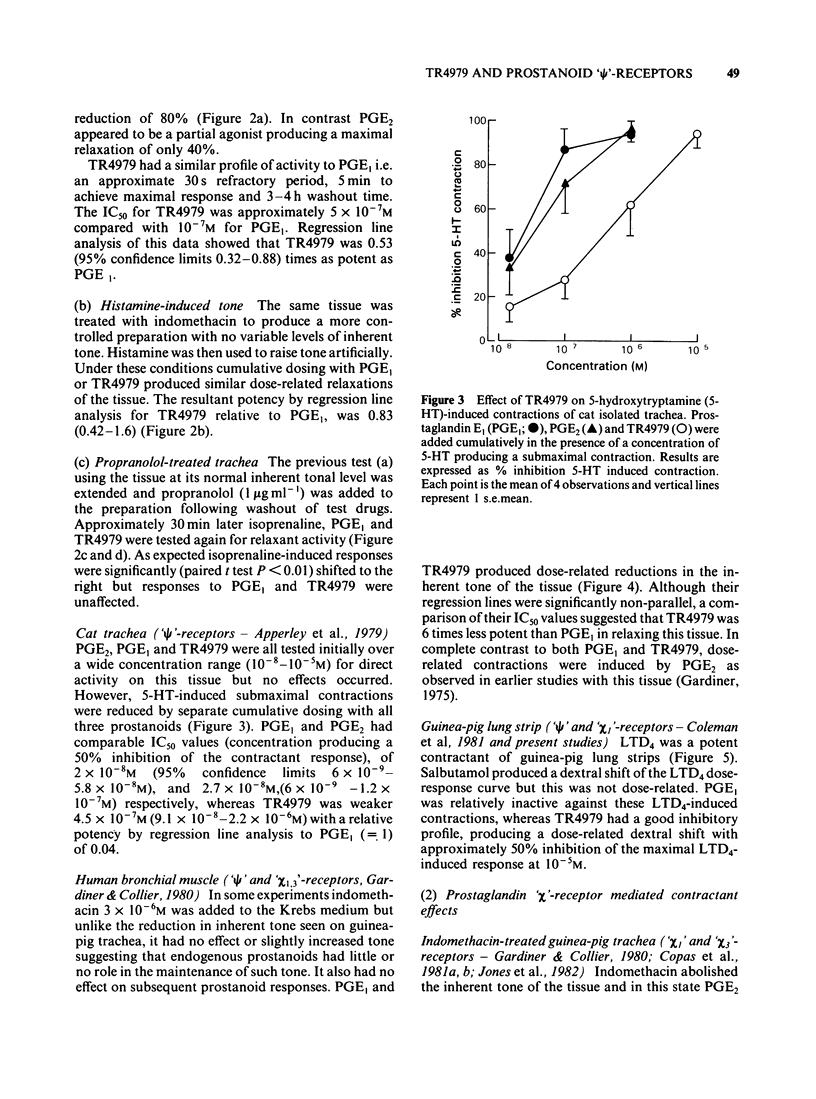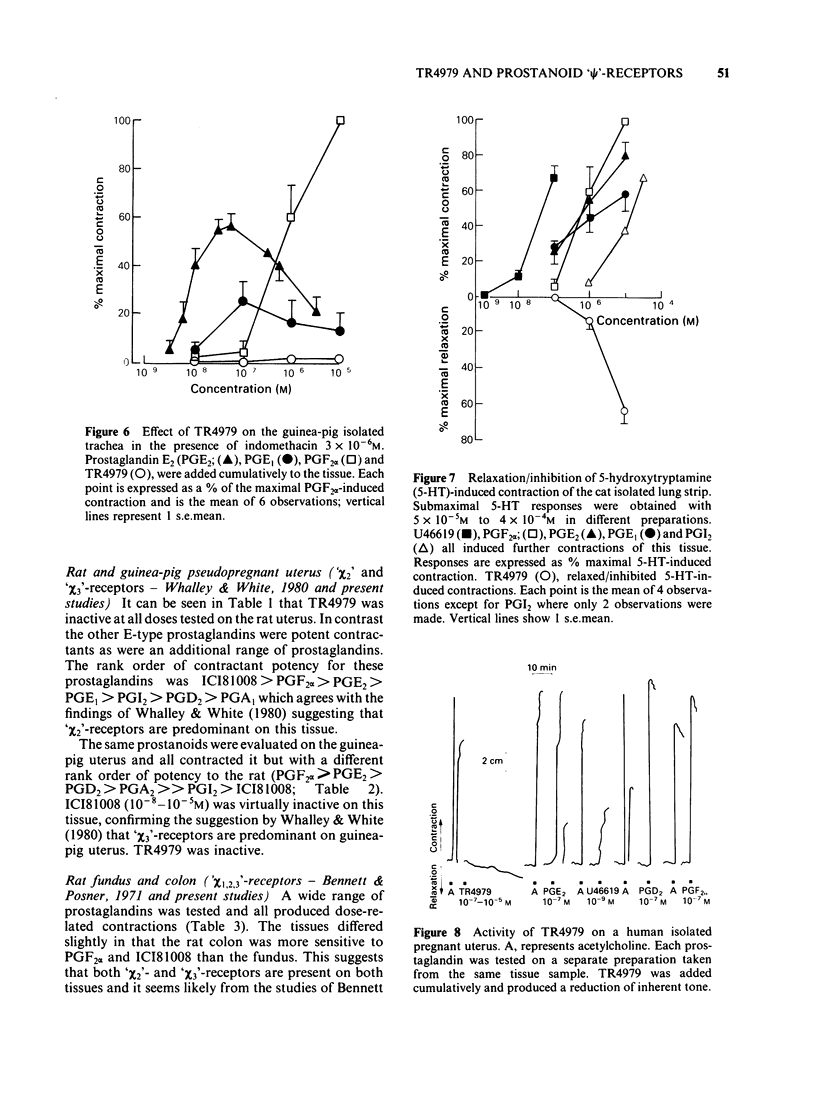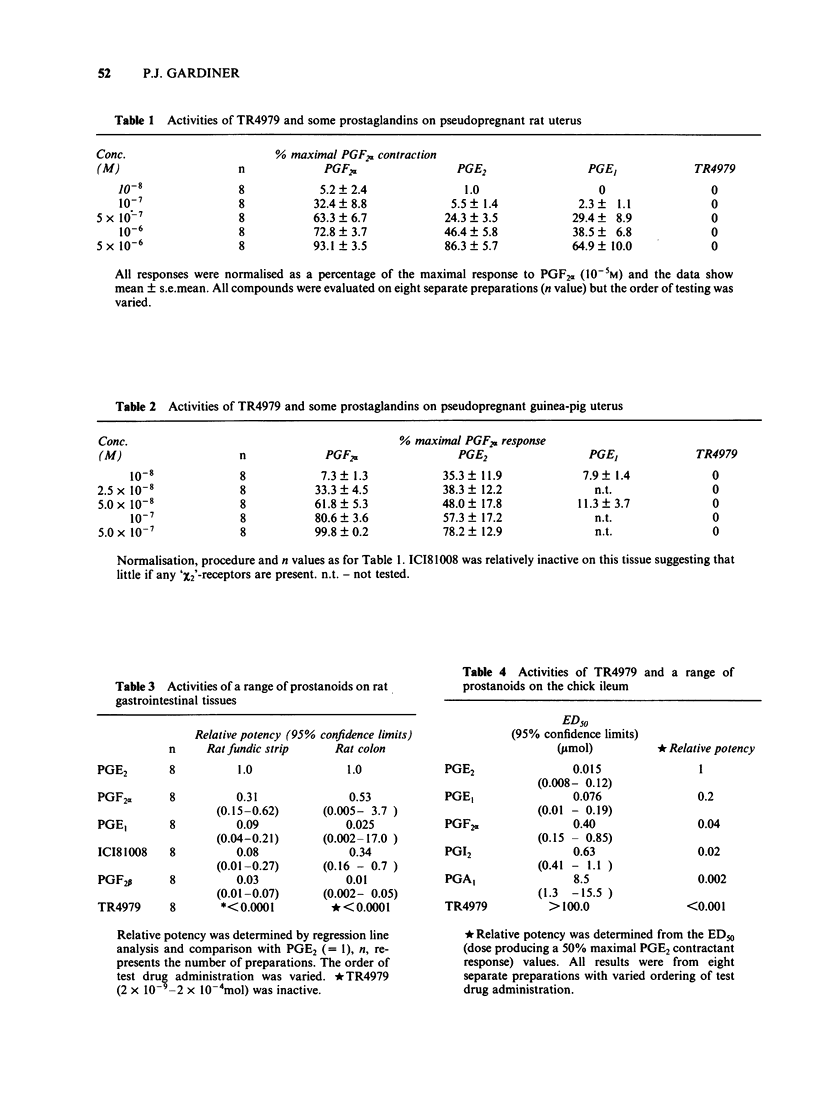Abstract
TR4979, an analogue of prostaglandin E1 (PGE1) was evaluated on respiratory and non-respiratory isolated tissues known to contain heterogeneous or homogeneous populations of the two classes of prostanoid (prostaglandins and thromboxanes) receptors. These receptors are classified as 'chi' the contractant/stimulant receptor with 'chi 1,2,3' being three subdivisions and 'psi' the relaxant/inhibitory receptor(s). On a respiratory tissue (cat trachea) containing predominantly 'psi'-receptors, TR4979 was 26 times less potent than PGE1 or PGE2. On other respiratory tissues known to contain mixtures of the 'chi 1,2,3'- and 'psi'-receptors (guinea-pig trachea and lung strip, cat lung strip and human bronchial muscle), TR4979 consistently acted as a potent relaxant whereas PGE2 and to a lesser extent PGE1 had significant contractant activities. Human pregnant uterus, guinea-pig and rat pseudo-pregnant uteri, rat colon and fundic strips and chick ileum are known to contain one or more of the three subclasses of the 'chi'-receptor. TR4979 (10(-9) -10(-5) M) was inactive on all these tissues whereas all of the reference prostanoids were contractants of varying potencies. PGE1 and histamine-induced contractions of the guinea-pig isolated ileum were both non-competitively antagonized by increasing concentrations of TR4979 suggesting that 'psi'-receptors also exist on this tissue. TR4979 is a highly selective agonist of prostanoid 'psi' (relaxant/inhibitory)-receptors which at present have been demonstrated to exist mainly in the lung. This prostaglandin analogue is a useful new selective pharmacological tool for revealing as yet unidentified prostanoid 'psi'-receptors and actions in a wide range of non-respiratory tissues/organs such as the guinea-pig ileum.
Full text
PDF











Selected References
These references are in PubMed. This may not be the complete list of references from this article.
- Apperley G. H., Coleman R. A., Kennedy I., Levy G. P. The cat isolated trachea, a useful preparation for the study of the smooth muscle relaxant action of prostaglandins [proceedings]. Br J Pharmacol. 1979 Nov;67(3):412P–413P. [PMC free article] [PubMed] [Google Scholar]
- Bennett A., Eley K. G., Scholes G. B. Effects of prostaglandins E1 and E2 on human, guinea-pig and rat isolated small intestine. Br J Pharmacol. 1968 Nov;34(3):630–638. doi: 10.1111/j.1476-5381.1968.tb08492.x. [DOI] [PMC free article] [PubMed] [Google Scholar]
- Bennett A., Jarosik C., Wilson D. E. A study of receptors activated by analogues of prostaglandin H2 [proceedings]. Br J Pharmacol. 1978 Jun;63(2):358P–358P. [PMC free article] [PubMed] [Google Scholar]
- Bennett A., Posner J. Studies on prostaglandin antagonists. Br J Pharmacol. 1971 Aug;42(4):584–594. doi: 10.1111/j.1476-5381.1971.tb07142.x. [DOI] [PMC free article] [PubMed] [Google Scholar]
- Coleman R. A., Humphrey P. P., Kennedy I., Levy G. P., Lumley P. Comparison of the actions of U-46619, a prostaglandin H2-analogue, with those of prostaglandin H2 and thromboxane A2 on some isolated smooth muscle preparations. Br J Pharmacol. 1981 Jul;73(3):773–778. doi: 10.1111/j.1476-5381.1981.tb16814.x. [DOI] [PMC free article] [PubMed] [Google Scholar]
- Cuthbert M. F. Effect on airways resistance of prostaglandin E1 given by aerosol to healthy and asthmatic volunteers. Br Med J. 1969 Dec 20;4(5685):723–726. doi: 10.1136/bmj.4.5685.723. [DOI] [PMC free article] [PubMed] [Google Scholar]
- Gardiner P. J., Browne J. L. Tussive activity of inhaled PGD2 in the cat and characterisation of the receptor(s) involved. Prostaglandins Leukot Med. 1984 Apr;14(1):153–159. doi: 10.1016/0262-1746(84)90034-9. [DOI] [PubMed] [Google Scholar]
- Gardiner P. J., Collier H. O. Specific receptors for prostaglandins in airways. Prostaglandins. 1980 Jun;19(6):819–841. doi: 10.1016/0090-6980(80)90116-1. [DOI] [PubMed] [Google Scholar]
- Gardiner P. J. The effects of some natural prostaglandins on isolated human circular bronchial muscle. Prostaglandins. 1975 Oct;10(4):607–616. doi: 10.1016/s0090-6980(75)80007-4. [DOI] [PubMed] [Google Scholar]
- Jones R. L., Peesapati V., Wilson N. H. Antagonism of the thromboxane-sensitive contractile systems of the rabbit aorta, dog saphenous vein and guinea-pig trachea. Br J Pharmacol. 1982 Jul;76(3):423–438. doi: 10.1111/j.1476-5381.1982.tb09236.x. [DOI] [PMC free article] [PubMed] [Google Scholar]
- Lulich K. M., Mitchell H. W., Sparrow M. P. The cat lung strip as an in vitro preparation of peripheral airways: a comparison of beta-adrenoceptor agonists, autacoids and anaphylactic challenge on the lung strip and trachea. Br J Pharmacol. 1976 Sep;58(1):71–79. doi: 10.1111/j.1476-5381.1976.tb07694.x. [DOI] [PMC free article] [PubMed] [Google Scholar]
- Mukhopadhyay A., Navran S. S., Amin H. M., Abdel-Aziz S. A., Chang J., Sober D. J., Miller D. D., Feller D. R. Effect of trimetoquinol analogs for antagonism of endoperoxide/thromboxane A2-mediated responses in human platelets and rat aorta. J Pharmacol Exp Ther. 1985 Jan;232(1):1–9. [PubMed] [Google Scholar]
- Nizankowska E., Sheridan A. Q., Maile M. H., Cross C. J., Nizankowski R., Prochowska K., Szczeklik A. Bronchodilatory properties of 2-decarboxy-2-hydroxymethyl prostaglandin E1. Prostaglandins. 1985 Mar;29(3):349–362. doi: 10.1016/0090-6980(85)90095-4. [DOI] [PubMed] [Google Scholar]
- Orehek J., Douglas J. S., Lewis A. J., Bouhuys A. Prostaglandin regulation of airway smooth muscle tone. Nat New Biol. 1973 Sep 19;245(142):84–85. doi: 10.1038/newbio245084a0. [DOI] [PubMed] [Google Scholar]
- Patscheke H., Stegmeier K., Müller-Beckmann B., Sponer G., Staiger C., Neugebauer G. Inhibitory effects of the selective thromboxane receptor antagonist BM 13.177 on platelet aggregation, vasoconstriction and sudden death. Biomed Biochim Acta. 1984;43(8-9):S312–S318. [PubMed] [Google Scholar]
- REGOLI D., VANE J. R. A SENSITIVE METHOD FOR THE ASSAY OF ANGIOTENSIN. Br J Pharmacol Chemother. 1964 Oct;23:351–359. doi: 10.1111/j.1476-5381.1964.tb01591.x. [DOI] [PMC free article] [PubMed] [Google Scholar]
- Sanner J. H. Antagonism of prostaglandin E2 by 1-acetyl-2-(8-chloro-10,11-dihydrodibenz (b,f) (1,4) oxazepine-10-carbonyl) hydrazine (SC-19220). Arch Int Pharmacodyn Ther. 1969 Jul;180(1):46–56. [PubMed] [Google Scholar]
- Svenssen J., Strandberg K., Tuvemo T., Hamberg M. Thromboxane A2: effects on airway and vascular smooth muscle. Prostaglandins. 1977 Sep;14(3):425–436. doi: 10.1016/0090-6980(77)90258-1. [DOI] [PubMed] [Google Scholar]
- Svensson J., Hamberg M., Samuelsson B. On the formation and effects of thromboxane A2 in human platelets. Acta Physiol Scand. 1976 Nov;98(3):285–294. doi: 10.1111/j.1748-1716.1976.tb10313.x. [DOI] [PubMed] [Google Scholar]
- Sweatman W. J., Collier H. O. Effects of prostaglandins on human bronchial muscle. Nature. 1968 Jan 6;217(5123):69–69. doi: 10.1038/217069a0. [DOI] [PubMed] [Google Scholar]
- VANE J. R. A sensitive method for the assay of 5-hydroxytryptamine. Br J Pharmacol Chemother. 1957 Sep;12(3):344–349. doi: 10.1111/j.1476-5381.1957.tb00146.x. [DOI] [PMC free article] [PubMed] [Google Scholar]
- VANE J. R. THE USE OF ISOLATED ORGANS FOR DETECTING ACTIVE SUBSTANCES IN THE CIRCULATING BLOOD. Br J Pharmacol Chemother. 1964 Oct;23:360–373. doi: 10.1111/j.1476-5381.1964.tb01592.x. [DOI] [PMC free article] [PubMed] [Google Scholar]
- Weichman B. M., Wasserman M. A., Gleason J. G. SK&F 88046: a unique pharmacologic antagonist of bronchoconstriction induced by leukotriene D4, thromboxane and prostaglandins F2 alpha and D2 in vitro. J Pharmacol Exp Ther. 1984 Jan;228(1):128–132. [PubMed] [Google Scholar]
- Whalley E. T., White S. K. Comparison of various prostaglandins (PG's) on the in vitro longitudinal uterine smooth muscle of the rat and guinea-pig. Br J Pharmacol. 1980 Jan;68(1):150P–151P. [PMC free article] [PubMed] [Google Scholar]


